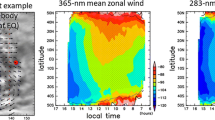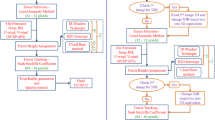Till now low-level winds were retrieved using Kalpana-1 infrared (IR) images only. In this paper, an attempt has been made to retrieve low-level cloud motion vectors using Kalpana-1 visible (VIS) images at every half an hour. The VIS channel provides better detection of low level clouds, which remain obscure in thermal IR images due to poor thermal contrast. The tracers are taken to be 15 × 15 pixel templates and hence each wind corresponds to about 120 km × 120 km at sub-satellite point. Multiplet based wind retrieval technique is followed for VIS wind derivation. However, for height assignment of VIS winds, collocated IR image is used. Due to better contrast between cloud and ocean surface, the low level atmospheric flow is captured better as compared to IR winds. The validation of the derived VIS winds is done with Global Forecast System (GFS) model winds and Oceansat-II scatterometer (OSCAT) winds.













Similar content being viewed by others
References
Deb S K, Kishtawal C M, Pal P K and Joshi P C 2008 A modified tracer selection and tracking procedure to derive winds using water vapor imagers; J. Appl. Meteor. Climatol. 47 3252–3263.
Deb S K, Kishtawal C M, Kaur I, Pal P K and Kumar A S K 2012 Multiplet based technique to derive atmospheric winds from Kalpana-1; In: Proc. 11th International Wind Workshop February 20–24, Auckland, New Zealand.
Forsythe Mary and Doutriax-Boucher 2005 Second analysis of data displayed on NWP SAF AMV monitoring Website; NWP SAF Technical Report 20.
Fujita T 1968 Present status of cloud velocity components from ATS-1 and ATS-3; COSPAR Space Res. 9 557–570.
Gohil B S, Sarkar A and Agarwal V K 2008 A new algorithm for wind vector retrieval from scatterometer; IEEE Geosci. Rem. Sens. Lett. 5 387–391.
Hayashi Masahiro 2012 Recent status and development of atmospheric motion vectors at JMA; In: Proc. 11th International Wind Workshop Febuary 20–24, Auckland, New Zealand.
Holmlund K L, Marie Doutriax-Boucher and Carranza M 2012 Current status of EUMETSAT operational winds; In: Proc. 11th International Wind Workshop Febuary 20–24, Auckland, New Zealand.
Hongmiong Q, Irwing A, Pennoyer W, Augembaum J and Zhang D 2010 Operational wind products at NOAA/NESDIS: A status report; In: Proc. 10th Int. Winds Workshop, Febuary 22–26, 2010, Tokyo, Japan.
Hubert L F and Whitney L F Jr 1971 Wind estimation from geostationary satellite pictures; Mon. Weather Rev. 99 665–672.
Kelly G 2004 Observing system experiments of all main data types in the ECMWF operational system; In: Proc. 3rd WMO Numer. Weather Prediction OSE Workshop, Alpbach, Austria, 32–36, WMO Tech Rep., 1228.
Kishtawal C M, Deb S K, Pal P K and Joshi P C 2009 Estimation of atmospheric motion vectors from Kalpana-1 imagers; J. Appl. Meteorol. Climatol. 48(11) 2410–2421.
Le Marshall J, Pescod N, Khaw A and Allen G 1993 The real time generation and application of cloud drift winds in the Australian region; Aust. Meteor. Mag. 42 89–103.
Nash J E and Sutcliffe J V 1970 River flow forecasting through conceptual models. Part I: A discussion principles; J. Hydrol. 10(3) 282–290.
Ottenbacher Andreas, Maria Tomassini, Kenneth Holmlund and Johannes Schmetz 1997 Low-level cloud motion winds from Meteosat High-Resolution Visible Imagery; Wea. Forecast. 12 175–184.
Oyama R 2010 Recent upgrades of and activities for atmospheric motion vectors at JMA/MSC; Proc. 10th Int. Winds Workshop, Febuary 22–26, Tokyo, Japan.
Qisong Z, Jianmin X, Xiaohu Z, Sujuan W, Gang M, Xiuquing H, Peng Z, Yong Z, Hua Z and Guiqing L 2010 Status of operational AMVs from FY-2 satellites; Proc. 10th Int. Winds Workshop, Febuary 22–26, Tokyo, Japan.
Rodgers E, Gentry R C, Shenk W and Oliver V 1979 The benefits of using short interval satellite images to derive winds for tropical cyclones; Mon. Weather Rev. 107 575–584.
Sohn Eunha, Sung-Rae Chung and Jong-Seo Park 2012 Current staus of COMS AMV in NMSC/KMA; In: Proc. 11th International Wind Workshop Febuary 20–24, Auckland, New Zealand.
Uchida H, Oshima T, Hamada T and Osano S 1991 Low-level cloud motion wind field estimated from GMS short interval images intyphoon vicinity; Geophys. Mag. 44 37–50.
Acknowledgements
The authors thank the anonymous reviewers for their critical and insightful comments/valuable suggestions, which were helpful in substantially improving the content and quality of presentation of this manuscript. The OSCAT Operational Standard Data Products are produced and distributed by National Remote Sensing Centre (NRSC: www.nrsc.gov.in). The authors would like to thank National Centers for Environmental Prediction (NCEP) for GFS Model analysis data and EUMETSAT (http://archive.eumetsat.int/, http://eportal.eumetsat.int) for providing METEOSAT-7 data. The Kalpana-1 data was sourced from MOSDAC (www.mosdac.gov.in). The authors are also thankful to the Director, Space Applications Centre, Indian Space Research Organisation and Deputy Director EPSA for their encouragement.
Author information
Authors and Affiliations
Corresponding author
Rights and permissions
About this article
Cite this article
KAUR, I., DEB, S.K., KISHTAWAL, C.M. et al. Low level cloud motion vectors from Kalpana-1 visible images. J Earth Syst Sci 122, 935–946 (2013). https://doi.org/10.1007/s12040-013-0334-7
Received:
Revised:
Accepted:
Published:
Issue Date:
DOI: https://doi.org/10.1007/s12040-013-0334-7




